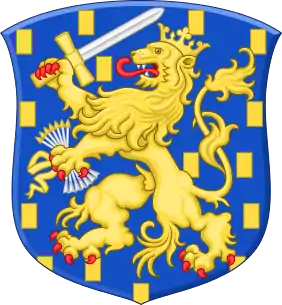Armed forces of the Netherlands
The Armed forces of the Netherlands consist of the Army, Navy, and Air Force.
| Armed forces of the Netherlands | |
|---|---|
| Nederlandse krijgsmacht | |
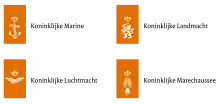 | |
| Founded | 1572 |
| Service branches | |
| Headquarters | Ministry of Defence, The Hague |
| Website | defensie.nl |
| Leadership | |
| Commander-in-Chief | The Government |
| Minister of Defence | Ank Bijleveld |
| Chief of Defence | Rob Bauer |
| Manpower | |
| Military age | 17[1] |
| Available for military service | 7,728,129, age 20 |
| Fit for military service | 6,324,217, age 20 |
| Reaching military age annually | 201,845 |
| Active personnel | 40,101[2] |
| Reserve personnel | 6,277[2] |
| Deployed personnel | 921[3] |
| Expenditures | |
| Budget | €11.728 billion ($13.748 billion) (2020)[4] |
| Percent of GDP | 1.48% (2020)[5] |
| Industry | |
| Domestic suppliers | Damen Group Thales Nederland Defenture |
| Foreign suppliers | |
| Related articles | |
| Ranks | Military ranks of the Netherlands |
The service branches consist of:
- Koninklijke Landmacht (KL), Royal Netherlands Army.
- Koninklijke Marine (KM), Royal Netherlands Navy and Korps Mariniers, Marine Corps.
- Koninklijke Luchtmacht (KLu), Royal Netherlands Air Force.
- Koninklijke Marechaussee (KMar), Royal Military Constabulary.
In addition, within the Kingdom of the Netherlands, there are small local conscript forces on the islands of Aruba (Arumil) and Curaçao (Antmil). These operate under the auspices of the Royal Netherlands Navy and Marines.
The military ranks of the Dutch armed forces have similarities with British and U.S. military ranks. The highest-ranking officer in the Dutch military is the Chief of Defence (Netherlands), who is a four-star officer (NATO OF-9).
Foundation in law and purpose
The Dutch armed forces exist by declaration in the constitution of the Netherlands. Article 97 of this constitution determines that the armed forces exist
- to defend the Kingdom of the Netherlands and its interests in the world; and
- to protect and advance the international rule of law.
This means that the role and responsibility of the Dutch military in international stability and peacekeeping is constitutionally determined.
The same article of the constitution determines that supreme command of the Dutch military resides with the Government of the Netherlands. This has been the case since the constitution was changed in 1983; before then, supreme command of the armed forces of the Netherlands was held by the King of the Netherlands.
In addition, a second major change in military affairs was made in 2003. Before then, all citizens of the Netherlands were tasked with the defense of the kingdom. In keeping with the move to a professional military, this article was dropped.
Central staff
| Chief of Defence | Appointed | Branch | ||
|---|---|---|---|---|
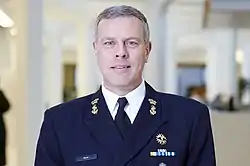 |
Lieutenant admiral Rob Bauer (born 1962) |
5 October 2017 (3 years, 121 days) |
Royal Netherlands Navy (Naval Squadron) | |
| Vice Chief of Defence | Appointed | Branch | ||
 |
Lieutenant general Onno Eichelsheim (born 1966) |
1 July 2019 (1 year, 217 days) |
Royal Netherlands Air Force (Attack Helicopters) | |
| Commander of the Army | Appointed | Branch | ||
 |
Lieutenant general Martin Wijnen (born 1966) |
28 August 2019 (1 year, 159 days) |
Royal Netherlands Army (Corps of Engineers) | |
| Commander of the Navy | Appointed | Branch | ||
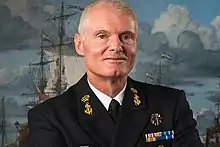 |
Vice admiral Rob Kramer (born 1962) |
22 September 2017 (3 years, 134 days) |
Royal Netherlands Navy (Naval Squadron) | |
| Commander of the Air Force | Appointed | Branch | ||
 |
Lieutenant general Dennis Luyt (born 1963) |
10 June 2016 (5 years, 238 days) |
Royal Netherlands Air Force (Fighters) | |
| Commandant of the Royal Marechaussee | Appointed | Branch | ||
 |
Lieutenant general Hans Leijtens (born 1963) |
2 September 2019 (1 year, 154 days) |
Royal Marechaussee (Police Service District Schiphol) | |
Military personnel
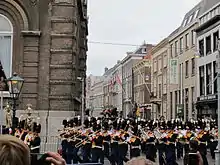
The Netherlands' military is currently a fully professional military. Conscription in the Netherlands was suspended in 1996 with the exception of Aruba and Curaçao.[6] All military branches and specialties are open to female recruits. In October 2018 the Dutch Ministry of Defence announced that the submarine service will also accept female recruits for positions as officer, NCO and sailor.
The Dutch Ministry of Defence employs over 61,000 personnel, including both civilian and military personnel.
The Dutch military is part of the NATO militaries and therefore conforms to the structure of a NATO military. It also uses conforming rank structures. All Dutch military personnel, officers and enlisted personnel, are required to take an oath of allegiance. This oath is recorded in the law on General Military Personnel Regulations (Algemeen Militair Ambtenarenregelement) in Article 126a.
Unionized military
Unlike many military organizations, Dutch military members are allowed to form and join unions.
There are four of these unions:
- Algemene Federatie van Militair Personeel (AFMP, General Federation of Military Personnel), which was recognized by the Dutch government in 1966. The AFMP is a member of the Dutch Federation of Trade Unions (FNV).
- Algemeen Christelijke Organisatie van Militairen (ACOM, General Christian Organisation for Military Personnel). The ACOM is a member of the Dutch Christian National Trade Union (CNV).
- Gezamenlijke Officieren Verenigingen en Middelbaar en Hoger Burgerpersoneel bij Defensie (GOV/MHB, United Officers Associations and Middle- and Seniorlevel Civilian Personnel), which was recognized by the Dutch government in 2004. The GOV/MHB is a member of the Dutch confederation of groups of middle and senior staffmembers.
- Vakbond voor Defensiepersoneel VBM (VBM, Union for Defence Personnel).
All unions represent both current and retired military personnel and/or civilian personnel.
Contemporary campaigns
Since the 1990s, the Dutch military has been involved in four major military campaigns:
- Bosnian War
- Kosovo War
- International Security Assistance Force in Afghanistan leading the effort in Uruzgan Province.
- Multinational force in Iraq
Afghanistan
As part of Operation Enduring Freedom as a response to those attacks, the Netherlands deployed aircraft as part of the European Participating Air Force (EPAF) in support of ground operations in Afghanistan as well as Dutch naval frigates to police the waters of the Middle East/Indian Ocean. The Netherlands deployed further troops and helicopters to Afghanistan in 2006 as part of a new security operation in the south of the country.[7] Dutch ground and air forces totalled almost 2,000 personnel during 2006, taking part in combat operations alongside British and Canadian forces as part of NATO's ISAF force in the south.
The Netherlands announced in December 2007 that it would begin withdrawing its troops from Afghanistan, which were mainly in Uruzgan Province, in July 2010. "I do not have assurances that other countries will be ready to replace Netherlands troops, but I am certain that Dutch troops will leave in 2010," Foreign Minister Maxime Verhagen said. "I indicated that in writing ... to the NATO secretary general, who has confirmed it."[8] In January 2009, Prime Minister Jan Peter Balkenende reiterated that the 1,600 Dutch troops in Afghanistan would end their mission in 2010, saying "We will stop in Uruzgan in 2010." He ruled out the possibility of the Netherlands keeping its troops in Afghanistan past 2010 with any force comparable to its former deployment.[9]
In December 2009, reacting to three requests received from the side of the U.S. by Vice President Biden, the special American representative to Afghanistan Holbrooke and Secretary of State Clinton and a request by Secretary General of NATO Rasmussen as well, the Dutch government announced that the final decision on the continuation of the mission in Uruzgan would be on its agenda in March 2010. Two ministers from the Labour Party (PvdA), Koenders (Development Aid) and Bos (Finance and Vice PM) in the meantime pleaded termination, which was also the opinion of the majority of the Dutch parliament.[10][11][12][13]
On 10 December 2009, the Dutch daily newspaper De Telegraaf reported that the government was exploring areas elsewhere in Afghanistan to set up a new mission. The northern province of Kunduz was mentioned, where at the moment German and Belgian troops were deployed. On 9 December, allegedly PM Balkenende (CDA), the vice-PM's Bos (PvdA) and Rouvoet (ChristenUnie) and the three involved ministers Verhagen (CDA, Foreign Affairs), Van Middelkoop (ChristenUnie, Defense) and Koenders (PvdA, (Development Aid) secretly discussed the future Dutch engagement in Afghanistan, together with Commander of the Forces general Van Uhm.[14][15]
In early February 2010, the disagreement between the PvdA on the one hand and CDA and ChristenUnie on the other about a request from NATO, by improper channels, for a renewed Dutch commitment in Afghanistan, came to a head. CDA and ChristenUnie wanted the freedom to consider this request—in spite of the decisions by the Minister of Defence and the votes in Parliament—whereas PvdA and a majority of the parties in the Dutch parliament stood by the earlier decision and refused any consideration of further Dutch involvement in Afghanistan. Thus, on 20 February, the PvdA had no choice but to resign their ministers from the Cabinet, leading to a collapse of the Dutch government. As a result, the NATO request could not be considered and Dutch troops withdrew later in 2010 according to the schedule agreed in 2007.[16]
On 1 August 2010 the Dutch military formally declared its withdrawal from its four-year mission in Afghanistan; most soldiers are expected to be back in the Netherlands by September, excepting those working on the reset, redistribution and repatriation of materiel and supplies. The AH-64 Apache and F-16 squadron will remain longer in Afghanistan to support the withdrawal process and transports.[17] The Dutch contingent has been replaced by soldiers from the U.S., Australia, Slovakia, and Singapore.
References
- Werken bij de landmacht – required age, Dutch army
- , Aantallen personeel
- , Ministry of Defence, Facts & Data
- "Financiën | Over Defensie | Defensie.nl" (in Dutch). Ministry of Defence (Netherlands). 2020. Retrieved 20 August 2020.
- "Prinsjesdag: Nadruk voor Defensie op digitalisering en duurzaamheid". Ministry of Defence. 25 June 2019. Retrieved 15 September 2020.
- "Suspended" in this case means that no conscripts are called up in the Netherlands; the legal mechanism for the draft is still in place.
- "More Dutch troops for Afghanistan". BBC News. 3 February 2006. Retrieved 7 June 2012.
- "Netherlands confirms 2010 Afghanistan pullout" (in Chinese). ABCnet.au. 19 December 2007. Retrieved 7 June 2012.
- "Dutch troops to exit Afghanistan in 2010". Brisbane Times. 24 January 2009. Retrieved 7 June 2012.
- Door onze redacteur Mark Kranenburg. "Druk op Nederland om te blijven in Afghanistan". Nrc.nl. Archived from the original on 8 December 2009. Retrieved 7 June 2012.
- Door onze correspondent Petra de Koning. "Holbrooke 'hoopt dat Nederland in Afghanistan blijft'". Nrc.nl. Archived from the original on 18 March 2010. Retrieved 7 June 2012.
- Door een onzer redacteuren. "Verzoek Clinton blijf in Uruzgan". Nrc.nl. Archived from the original on 6 December 2009. Retrieved 7 June 2012.
- Door een onzer redacteuren. "Spanning stijgt in coalitie om inzet in Uruzgan". Nrc.nl. Archived from the original on 11 March 2010. Retrieved 7 June 2012.
- "Noord-Afghanistan in beeld". Telegraaf.nl. 10 December 2009. Retrieved 7 June 2012.
- "Geheim kabinetsberaad over nieuwe missie Afghanistan". Elsevier.nl. 10 December 2009. Retrieved 7 June 2012.
- Marquand, Robert (22 February 2010). "Dutch government collapse: Will other European troops now leave Afghanistan?". The Christian Science Monitor. Archived from the original on 28 March 2010.
- UPI (1 August 2010). "Netherlands begins Afghan troop withdrawal". Retrieved 1 August 2010.
 This article incorporates public domain material from the CIA World Factbook document: "2006 edition".
This article incorporates public domain material from the CIA World Factbook document: "2006 edition".
External links
| Wikimedia Commons has media related to Military of the Netherlands. |
